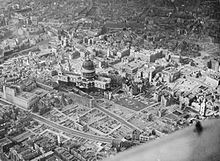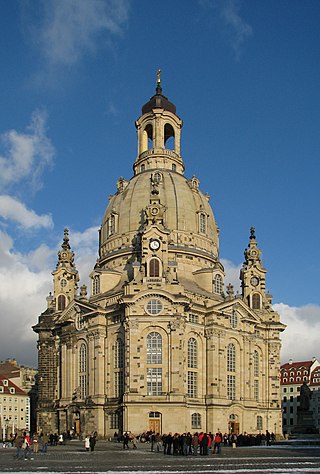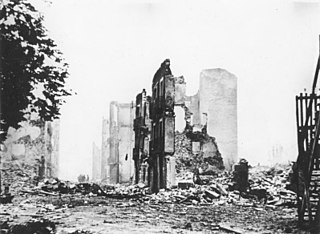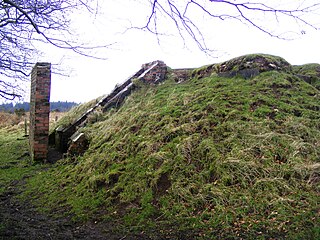The examples and perspective in this article may not include all significant viewpoints .(December 2010) |

A bombsite is the wreckage that remains after a bomb has destroyed a building or other structure.
The examples and perspective in this article may not include all significant viewpoints .(December 2010) |

A bombsite is the wreckage that remains after a bomb has destroyed a building or other structure.
After World War II many European cities remained severely damaged from bombing. London and other British cities which had suffered the Blitz were pock-marked with bombsites, vacant lots covered in the rubble of destroyed buildings. Many postwar children in urban areas shared a common memory of playing their games and riding their bicycles across these desolate environments. [1] [2] There were often abandoned bombshelters of the 'Anderson' type nearby.
In London, Liverpool, Bristol, etc., across the channel in Berlin and other places these sites were constant reminders of the death and destruction of the war. This was a contributory factor to the European psycho-sociological outlook of the 1950s and 1960s. [3] [4] [5] The German city of Dresden suffered a previously unprecedented level of destruction. [6]
The rubble of Viennese bombsites and the remnants of the city's battered infrastructure serve as a backdrop to much of the action in the movie The Third Man , written by Graham Greene, an author who would return to this bombsite motif again in his 1954 short story "The Destructors".

The bombing of Dresden was a joint British and American aerial bombing attack on the city of Dresden, the capital of the German state of Saxony, during World War II. In four raids between 13 and 15 February 1945, 772 heavy bombers of the Royal Air Force (RAF) and 527 of the United States Army Air Forces (USAAF) dropped more than 3,900 tons of high-explosive bombs and incendiary devices on the city. The bombing and the resulting firestorm destroyed more than 1,600 acres (6.5 km2) of the city centre. Up to 25,000 people were killed. Three more USAAF air raids followed, two occurring on 2 March aimed at the city's railway marshalling yard and one smaller raid on 17 April aimed at industrial areas.

The Blitz was a German bombing campaign against the United Kingdom, in 1940 and 1941, during the Second World War. The term was first used by the British press and originated from the term Blitzkrieg, the German word meaning 'lightning war'.

The Dresden Frauenkirche is a Lutheran church in Dresden, the capital of the German state of Saxony. Destroyed during the Allied firebombing of Dresden towards the end of World War II, the church was reconstructed between 1994 and 2005.

World War II (1939–1945) involved sustained strategic bombing of railways, harbours, cities, workers' and civilian housing, and industrial districts in enemy territory. Strategic bombing as a military strategy is distinct both from close air support of ground forces and from tactical air power. During World War II, many military strategists of air power believed that air forces could win major victories by attacking industrial and political infrastructure, rather than purely military targets. Strategic bombing often involved bombing areas inhabited by civilians, and some campaigns were deliberately designed to target civilian populations in order to terrorize them and disrupt their usual activities. International law at the outset of World War II did not specifically forbid the aerial bombardment of cities – despite the prior occurrence of such bombing during World War I (1914–1918), the Spanish Civil War (1936–1939), and the Second Sino-Japanese War (1937–1945).

On 26 April 1937, the Basque town of Guernica was aerial bombed during the Spanish Civil War. It was carried out at the behest of Francisco Franco's rebel Nationalist faction by its allies, the Nazi German Luftwaffe's Condor Legion and the Fascist Italian Aviazione Legionaria, under the code name Operation Rügen. The town was being used as a communications centre by Republican forces just behind the front line, and the raid was intended to destroy bridges and roads. The operation opened the way to Franco's capture of Bilbao and his victory in northern Spain.

Hightown is a village and civil parish in the Metropolitan Borough of Sefton in Merseyside, England, located midway between the city of Liverpool and the coastal resort of Southport. It is 8 miles north of Liverpool city centre and is located on the coast near the boundary of the Mersey Estuary and Liverpool Bay. The River Alt joins the sea at this point and forms an estuary. There is a pumping station on the River Alt at Altmouth, built 1972, as part of a programme to alleviate flooding in the area. This is on the Altcar Rifle Range, a Territorial Army base originally established in 1860 by Lt. Col. Gladstone.

The Liverpool Blitz was the heavy and sustained bombing of the English city of Liverpool and its surrounding area, during the Second World War by the German Luftwaffe.

The Bombing of Würzburg in World War II was a large-scale air attack on the city of Würzburg, and was part of the strategic bombing campaign by the Allies against Nazi Germany. Although lacking major armaments industries and hosting around 40 hospitals at the time, Würzburg was targeted as a traffic hub and as part of the attempt by Bomber Command to break the spirit of the German people. The major raid occurred on March 16, 1945, when Royal Air Force bombers dropped incendiary bombs that set fire to much of the city, killing an estimated 5,000 people and almost completely obliterating the historic town. Almost 90% of the buildings were destroyed by a raid that lasted less than 20 minutes.

Castle Park is a public open space in Bristol, England, managed by Bristol City Council. It is bounded by the Floating Harbour and Castle Street to the south, Lower Castle Street to the east, and Broad Weir, Newgate and Wine Street to the north. Its western boundary is less obviously defined and has been the subject of controversy, perhaps because the area around High Street and St Mary le Port Church, though not part of the park and always intended for development, is often considered at the same time as the park.

The Bristol Blitz was the heavy bombing of Bristol, England by the Nazi German Luftwaffe during the Second World War. Due to the presence of Bristol Harbour and the Bristol Aeroplane Company, the city was a target for bombing and was easily found as enemy bombers were able to trace a course up the River Avon from Avonmouth using reflected moonlight on the waters into the heart of the city. Bristol was the fifth-most heavily-bombed British city of the war.

Pompeii and Herculaneum were once thriving towns, 2,000 years ago, in the Bay of Naples. Both cities have rich histories influenced by Greeks, Oscans, Etruscans, Samnites and finally the Romans. They are most renowned for their destruction: both were buried in the AD 79 eruption of Mount Vesuvius. For over 1,500 years, these cities were left in remarkable states of preservation underneath volcanic ash, mud and rubble. The eruption obliterated the towns but in doing so, was the cause of their longevity and survival over the centuries.
Core-and-veneer, brick and rubble, wall and rubble, ashlar and rubble, and emplekton all refer to a building technique where two parallel walls are constructed and the core between them is filled with rubble or other infill, creating one thick wall. Originally, and in later poorly constructed walls, the rubble was not consolidated. Later, mortar and cement were used to consolidate the core rubble and produce sturdier construction.

Starfish sites were large-scale night-time decoys created during the Blitz to simulate burning British cities. The aim was to divert German night bombers from their intended targets so they would drop their ordnance over the countryside. The sites were an extension of Colonel John Turner's decoy programme for airfields and factories. Following the bombing, and near destruction, of Coventry in November 1940, Turner was tasked with creating decoys for seven major cities.

Marshal of the Royal Air Force Sir Arthur Travers Harris, 1st Baronet,, commonly known as "Bomber" Harris by the press and often within the RAF as "Butch" Harris, was Air Officer Commanding-in-Chief (AOC-in-C) RAF Bomber Command during the height of the Anglo-American strategic bombing campaign against Nazi Germany in the Second World War.
One World Archaeology is a book series focussing on archaeology and education about the past.

Air forces of the United Nations Command carried out an extensive bombing campaign against North Korea from 1950 to 1953 during the Korean War. It was the first major bombing campaign for the United States Air Force (USAF) since its inception in 1947 from the United States Army Air Forces. During the campaign, conventional weapons such as explosives, incendiary bombs, and napalm destroyed nearly all of the country's cities and towns, including an estimated 85% of its buildings.
Hermann Claasen was a German photographer.

The War in the Empty Air: Victims, Perpetrators, and Postwar Germans is a non-fiction work by Dagmar Barnouw, then Professor of German and Comparative Literature at the University of Southern California. Published in 2005 by Indiana University Press, the book explores the situation of the German people after their government's surrender to the Allies on 8 May 1945 at the end of World War II.
Project Thunderbird was a 1967 United States Atomic Energy Commission (AEC) proposal to use nuclear explosives to prepare coalbeds to gasify coal in place underground in Wyoming. The project was proposed as a component of Project Plowshare, which sought ways to use nuclear devices in public works and industrial development projects. The project aimed to exploit deep coal deposits to gasify them in situ with controlled combustion in the rubble chimney resulting from a deep nuclear detonation. The project was to be located on the border of Johnson County and Campbell County|, about 20 miles (32 km) west of Gillette, Wyoming, in the Powder River Basin.
{{cite journal}}: Missing or empty |title= (help)